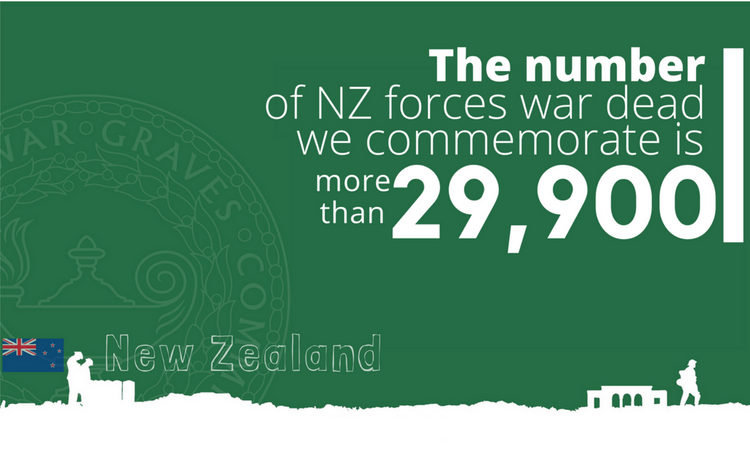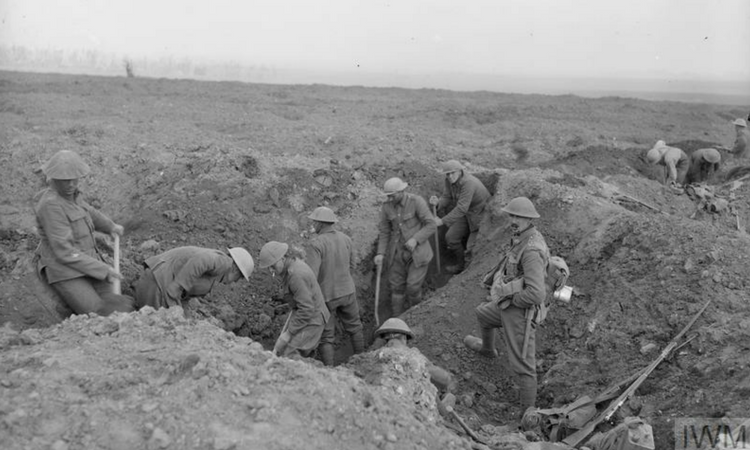06 February 2018
CWGC marks New Zealand’s Waitangi Day
The Commission commemorates almost 30,000 members of New Zealand forces who died during the two world wars. Here are 5 facts about New Zealand forces in the First and Second World War, and some of the CWGC cemeteries and memorials where they are commemorated.

- More than 100,000 New Zealand troops and nurses served overseas with the New Zealand Expeditionary Force during the First World War, while many others served with British and other Dominion forces.
- New Zealand forces played a key role at Gallipoli, Turkey, in Egypt and the Near East, and on the Western Front; including at Longueval on the Somme, and in the capture of Messines Ridge.
- More than 140,000 New Zealand personal served overseas with the 2nd New Zealand Expeditionary Force during the Second World War, while a further 100,000 served on home defense.
- New Zealand forces fought in the deserts of North Africa, the plains and mountains of Italy and among the islands of the South Pacific. Today, headstones bearing the fern of New Zealand can be found across Egypt, Libya and Tunisia, Italy and New Caledonia.
- The CWGC commemorates more than 29,900 members of New Zealand forces who died during the two world wars – more than 18,000 of the First World War and almost 12,000 of the Second World War.
Remembering New Zealand forces

Battle of Flers-Courcelette - New Zealanders making a trench, near Martinpuich, 15 September 1916, © IWM (Q 193)
CWGC Chunuk Bair Cemetery and Memorial
In August 1915 New Zealand forces took part in a major action at Gallipoli in Turkey. After months of deadlock, Allied forces went  on the offensive hoping to break the stalemate. The attack began in darkness as New Zealand units advanced with bayonets towards the heights of Chunuk Bair, the highest peak on the peninsula. Chunuk Bair was captured at high cost, but was lost several days letter to a determined Ottoman counter-attack.
on the offensive hoping to break the stalemate. The attack began in darkness as New Zealand units advanced with bayonets towards the heights of Chunuk Bair, the highest peak on the peninsula. Chunuk Bair was captured at high cost, but was lost several days letter to a determined Ottoman counter-attack.
Constructed after the Armistice, Chunuk Bair Cemetery was built where Ottoman troops had buried some of their enemies following the August battle. Today, it is the final resting place of more than 630 servicemen. The names of only 10 are known. Above the cemetery is the Chunuk Bair New Zealand Memorial. It bears the names of 850 members of New Zealand forces who fought at Chunuk Bair and the surrounding area in 1915, and have no known grave. It is one of four CWGC memorials bearing the names of those who served with New Zealand forces on Gallipoli which, when combined, commemorate more than 1,900 members of New Zealand forces.
CWGC Caterpillar Valley Cemetery and Memorial
 On 15 September 1916, the New Zealand force fought its first major action on the Western Front during the Battle of the Somme. New Zealand troops went into action just southwest of the village of Flers. For three weeks the division was continually engaged. The village along with the German lines beyond were captured, but it suffered more than 7,000 casualties of whom 2,000 were killed.
On 15 September 1916, the New Zealand force fought its first major action on the Western Front during the Battle of the Somme. New Zealand troops went into action just southwest of the village of Flers. For three weeks the division was continually engaged. The village along with the German lines beyond were captured, but it suffered more than 7,000 casualties of whom 2,000 were killed.
Today, Caterpillar Valley Cemetery looks across to where the New Zealand Division fought in September 1916. It is the second largest CWGC cemetery on the Somme and is the final resting place of more than 5,500 servicemen, including some 200 members of New Zealand forces. Due to its New Zealand connection, the CWGC Caterpillar Valley New Zealand Memorial was constructed here after the war. It bears the names of more than 1,200 members of New Zealand forces who died on the Somme in 1916 and have no known grave.
In 2004, the remains of an unidentified soldier of New Zealand forces was exhumed from Caterpillar Valley in a special ceremony. He was taken back to New Zealand where he was laid to rest in the Tomb of the Unknown Warrior at the National War Memorial in Wellington. His former grave is marked by a special headstone.
CWGC Knightsbridge War Cemetery
 This cemetery in Libya was begun during fierce fighting in 1942. Commonwealth forces had dug in west of Tobruk, with defences consisting of a number of strong points or 'boxes' linked by deep minefields. The main 'box' was known as Knightsbridge. During the fighting soldiers buried their fallen comrades in a battlefield cemetery, and after the war many graves were brought here from smaller burial grounds and scattered sites in the desert. Today, the cemetery is the final resting place of some 3,600 Commonwealth servicemen. Among the graves are those of nearly 500 New Zealand soldiers, making this the third largest concentration of New Zealand graves in the world.
This cemetery in Libya was begun during fierce fighting in 1942. Commonwealth forces had dug in west of Tobruk, with defences consisting of a number of strong points or 'boxes' linked by deep minefields. The main 'box' was known as Knightsbridge. During the fighting soldiers buried their fallen comrades in a battlefield cemetery, and after the war many graves were brought here from smaller burial grounds and scattered sites in the desert. Today, the cemetery is the final resting place of some 3,600 Commonwealth servicemen. Among the graves are those of nearly 500 New Zealand soldiers, making this the third largest concentration of New Zealand graves in the world.
The commander of German forces in North Africa, Erwin Rommel, wrote that the New Zealand Division ‘...was among the elite of the British Army and I should have been very much happier if it had been safely tucked away in our prison camps instead of still facing us’.
Captain Anthony Frederick Wilding
Born in Christchurch, New Zealand, Anthony Wilding was a  former Wimbledon tennis champion. His tennis career began with him winning the Canterbury Championships aged 17. He won 11 Grand Slam tournament titles, six in singles and five in doubles. He also won a bronze medal for indoor singles tennis at the 1912 Olympics.
former Wimbledon tennis champion. His tennis career began with him winning the Canterbury Championships aged 17. He won 11 Grand Slam tournament titles, six in singles and five in doubles. He also won a bronze medal for indoor singles tennis at the 1912 Olympics.
Shortly after the outbreak of the First World War, Anthony joined the Royal Marines. He later served with the Royal Naval Armoured Car Division in the battlefields of northern France. In May 1915, he was promoted to Captain just days before he was killed during the Battle of Aubers Ridge at Neuve-Chapelle, France, when a shell exploded on the roof of the dug-out he was sheltering in.
He is buried at Rue-des-Berceaux Military Cemetery in France.

